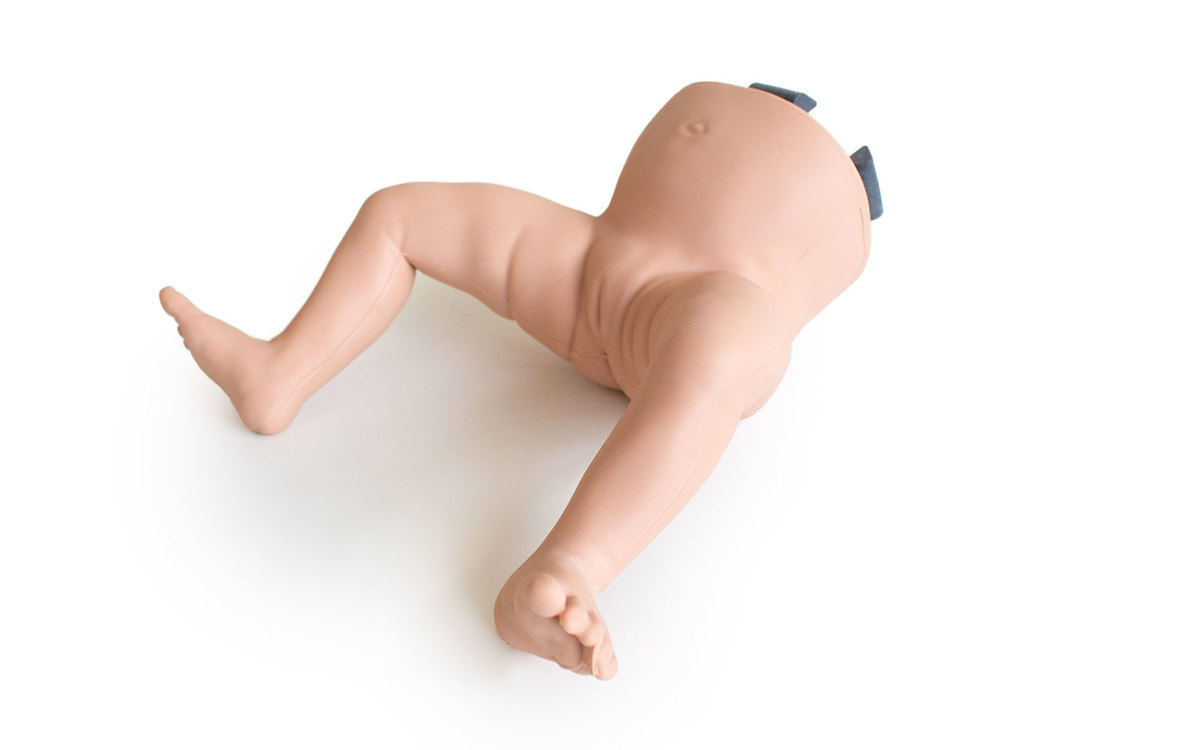








Developmental dysplasia of the hip (DDH) occurs in approximately 1 or 2 babies in 1,000. The Limbs & Things Infant Hip Exam Trainer has been designed to meet the specific requirements of healthcare professionals training to identify and diagnose DDH.
Limbs & Things worked with leading American paediatrician, Dr Joseph O. Lopreiato, a specialist in Simulation Education, and Elizabeth Weissbord, MA, CMI, to develop this infant hip simulation model.
This infant hip trainer comes with 2 interchangeable lower leg modules that allow trainees to identify the differences between normal and abnormal hip pathologies. The Lower Abnormal hip module’s range of motion gives trainees a realistic representation of the following:
- Dislocating a hip that is lax in the socket
- Relocating a hip that is dislocated from the socket, feeling the “clunk” as the procedure is completed
- Using the Galeazzi sign to identify the visual signs of DDH
- Using both the Ortolani Test and Barlow Manoeuvre on both hip pathologies
An infant torso module was included in the trainer to provide a weighted model that has greater stability when in use. It also increases realism over a simple lower leg module.
Overview
- The infant hip trainer is quick and easy to set up
- Our durable model allows for repeated training using the Ortolani Test and Barlow Manoeuvre
- The Infant Hip Examination Trainer comes with two hip modules:
- Normal hip module – this allows trainees to understand the haptics of how a normal hip would react during an examination
- Abnormal hip module - one hip that is dislocated and can be manoeuvred into the correct position and the other hip is lax and can be dislocated, both using the Ortolani Test and Barlow Manoeuvre
- Articulated knee and ankle joints mean the baby’s feet can be placed flat on a bed replicating the Galeazzi sign
Realism
- A realistic ‘clunk’ can be felt when resetting the dislocated hip
- This model is anatomically accurate for a 1 month old female infant
Versatility
• Interchangeable lower modules allow trainees to recognize normal hips as well as two types of abnormal hip
Safety
- This product is latex free
Anatomy
- Palpable greater trochanter on the left and right femurs to aid correct hand placement
- The infant hip simulator has: articulating hip, knee and ankle joints for the Barlow and Ortolani manoeuvres and Galeazzi sign
Skills Gained
- Performing the Ortolani test
- Performing the Barlow manoeuvre
- Recognising the Galeazzi sign
References
"In the appropriate setting, the resident should demonstrate the ability to apply knowledge of newborn physical exam, including weight, heart exam, hip exam, testicular exam, etc. Diagnosis and role-appropriate management of developmental dysplasia of the hip Evaluate and manage common signs and symptoms that present in the context of acute medical care in the inpatient or outpatient setting. Hip disorders: Aseptic necrosis of the femoral head (Legg-Calve-Perthes disease), developmental dysplasia of the hip (DDH), slipped capital femoral epiphysis (SCFE), toxic synovitis"
"Fellows must demonstrate competence in the performance of pediatric orthopedic operative and non-operative procedures, including procedures for developmental dysplasia of the hip (DDH) prior to walking age (Core). Fellows must demonstrate competence in their knowledge of DDH prior to walking age; (Core)"
"Permit the student to perform all the required management activities for assigned patients under appropriate supervision. These activities include, but are not limited to, the following: admitting patients to the nursery, obtaining the perinatal and neonatal history, performing physical examinations, developing the differential diagnosis, and proposing the initial management plan Independent Practice Competencies: Performs a complete, systems-focused examination to include physical, behavioral, and developmental Health Promotion and Disease Prevention: Primary care for infants through age 2: Common pediatric primary care disorders (under age 2): Hip dysplasia"
"Theme 2: Care of the Well Newborn: identify screening tests, such as newborn examination including hip exam, newborn screening test and hearing screening Theme 3: Care of the Sick Newborn: assess and diagnose infants with talipes and congenital dysplastic hip."
"Carries out an assessment, makes a differential diagnosis, plans appropriate investigations and initiates a treatment plan. Neonates: Management: Assesses developmental dysplasia of the hip and makes appropriate referrals."
"Full systematic physical examination of the newborn infant in line with local and national evidence-based protocols."
-
User Guide
Developmental Dysplasia Of Hip Curriculum V3
PDF | 3.2 MB
-
Product Brochure
Infant Hip Exam UK V1 Web
PDF | 432.3 KB
-
Product Brochure
Infant Hip Exam SP V1
PDF | 434.1 KB
-
Product Brochure
Infant Hip Exam FR Web V1
PDF | 434.4 KB
-
Product Brochure
Infant Hip Exam DE Web V1
PDF | 433.2 KB
-
Product Brochure
Infant Hip Exam CN Web V1
PDF | 644.5 KB
What manoeuvres can the Infant Examination Trainer demonstrate?
With both lax and dislocated hips represented in the model, and a strong range of movement, trainees are able to relocate and dislocate both hips with the Ortolani Test or the Barlow Manoeuvre.
____________________________________
What is the benefit of using the Limbs & Things multiple module infant hip trainer
Our full body trainer is weighted and sized for a 1 month old female, this means that trainees can get comfortable conducting a hip exam with a realistic model. The interchangeable lower modules are easily fitted in under a minute, meaning that there is little disruption during training scenarios.
The model’s durability also means that trainees can repeatedly practice the procedures, helping them build confidence and develop muscle memory for the techniques involved, before performing the exam on a patient.
____________________________________




